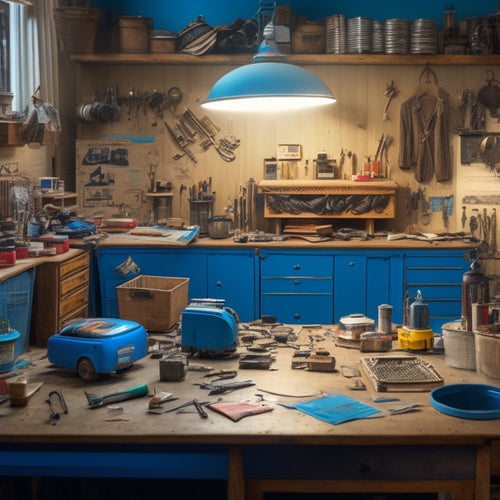
What's the Best Cleaning Schedule for Homeowners?
Share
You need a cleaning schedule that's tailored to your lifestyle and living situation to maintain a clean and organized home, and it all starts with a daily routine that sets the tone for the rest of your cleaning tasks. Dedicate 10-15 minutes daily to a quick walk-through to catch clutter and messes before they spiral out of control. Set aside one day a week to tackle dusting, and every other week, focus on rinsing surfaces that require water to stay clean and hygienic. From there, you can build a schedule that works for you, and discover the ideal cleaning rhythm for your unique space.
Key Takeaways
• Set aside 10-15 minutes daily for a quick walk-through to catch clutter and messes before they spiral out of control.
• Dedicate one day a week to tackle dusting, focusing on high-traffic areas and working down to lower surfaces.
• Schedule bi-weekly tasks to rinse surfaces that require water to stay clean and hygienic, such as sinks and shower doors.
• Perform quarterly cleaning tasks, including inspecting and maintaining equipment, to ensure they're running efficiently and effectively.
• Customize and adjust the cleaning schedule based on personal preferences, lifestyle, and high-traffic areas to ensure a realistic and effective cleaning routine.
Daily Inspection for Optimal Performance
By dedicating just 10-15 minutes each day to a quick walk-through, you can catch clutter and messes before they spiral out of control.
This daily inspection is a vital part of maintaining a clean and organized home. Start your morning routine by incorporating this quick fix into your daily habits.
Take a few minutes to speed clean high-traffic areas, put away any clutter, and make your bed. This fresh start will give you a sense of accomplishment and motivation to tackle the day.
Incorporate daily reminders to stay on track and maintain your space.
Make it a habit to quickly tidy up after meals, and take a few minutes to wipe down surfaces after breakfast. These quick tips will help you establish a routine that becomes second nature.
As you make daily inspections a part of your morning routine, you'll find that maintaining your home becomes easier and less overwhelming. With a clear plan and consistent effort, you'll be on your way to a cleaner, more organized home.
Weekly Dusting for Maximum Efficiency
To maximize efficiency, set aside one day a week, such as Saturday morning, to tackle dusting, a task that'll keep your furniture and decorations looking their best.
By dedicating a specific day to dusting, you'll maintain a consistent and efficient routine.
Start by gathering your dusting supplies, including a microfiber cloth, feather duster, or vacuum with a gentle suction setting.
Begin with high-traffic areas and work your way down to lower surfaces, using gentle, sweeping motions to remove dust and dirt.
For more delicate items, like decorative figurines or electronics, use a soft-bristled brush or a can of compressed air to gently remove dust.
To make the most of your weekly dusting session, focus on one room at a time, breaking down larger areas into smaller, manageable sections.
This will help you stay on track and guarantee a thorough job.
Bi-Weekly Water Rinsing Schedule
Every other week, you'll want to set aside some time to rinse surfaces that require water to stay clean and hygienic. This bi-weekly water rinsing schedule is essential for maintaining a clean and healthy home.
By incorporating this routine, you'll be able to prevent dirt and grime from building up and creating an ideal environment for bacteria and germs to thrive.
Some essential areas to focus on during your bi-weekly water rinsing schedule include:
Sinks and faucets: Rinse away any soap scum, toothpaste, and food particles that can leave unsightly stains and harbor bacteria.
Shower doors and walls: Remove soap scum, mildew, and mineral deposits that can make your shower look dull and uninviting.
Toilet handles and seats: Give your toilet a thorough rinse to eliminate germs and bacteria that can spread illness.
Monthly Debris Removal Essentials
Remove clutter and debris that's accumulated in high-traffic areas and storage spaces by dedicating one day a month to tackling these often-overlooked hotspots. This monthly debris removal is essential for maintaining Clutter Control and preventing the buildup of unwanted items that can attract pests and create unsanitary conditions.
| Area | Task | Frequency |
|---|---|---|
| Garage/Attic | Remove unwanted items, sort and categorize stored items | Monthly |
| Yard | Collect Yard Waste, trim trees and bushes | Monthly |
| Closets | Remove out-of-season clothing, donate or discard | Monthly |
| Pantry | Expired food, clean shelves and containers | Monthly |
| Living Room | Dust and vacuum furniture, remove clutter | Monthly |
Quarterly Panel Inspection Checklist
As you tackle your quarterly cleaning tasks, don't forget to inspect your panels to guarantee they're running efficiently.
You'll want to check and replace your AC filters, inspect your coils for dirt and debris, and give your outdoor unit some TLC to keep it in top shape.
Quarterly AC Filter Check
You're due for a quarterly AC filter check, which involves inspecting and replacing the air filters in your home to guarantee your HVAC system runs efficiently and effectively. This crucial task ensures better indoor air quality, reduced energy bills, and prolonged equipment lifespan.
Filter Quality: Opt for high-quality filters with a MERV rating of 8-12 for optimal performance. These filters capture 90% of particles as small as 1 micron, ensuring cleaner air and reduced allergen exposure.
Filter Materials: Choose filters made from durable, washable materials like polyester or fiberglass. These materials ensure efficient airflow and are easy to clean or replace.
Filter Replacement: Replace filters every 1-3 months, depending on usage and manufacturer guidelines. Regular replacement prevents dust and debris buildup, which can lead to system failures and increased energy consumption.
Dirty Coil Inspection Needed
Now that your air filters are clean and efficient, it's time to turn your attention to the condenser coils, which require a quarterly inspection to guarantee your HVAC system operates at peak performance.
You'll want to inspect the coils for any signs of damage, dirt, or debris that could hinder airflow and reduce efficiency.
Check for coil design flaws, such as bent or crushed fins, which can impede airflow and increase energy bills.
Look for signs of refrigerant leaks, like oil stains or ice buildup, which can lead to compressor failure.
Make sure to inspect the coil's surrounding area, ensuring it's clear of obstacles and debris that could obstruct airflow.
Remove any leaves, twigs, or other obstructions that may be blocking the coils.
A clean and well-maintained condenser coil is essential for your HVAC system's overall performance and longevity.
Outdoor Unit Maintenance
Every quarter, inspect the outdoor unit's panel to verify it's securely fastened and free from signs of wear, corrosion, or damage that could compromise your HVAC system's performance. This routine maintenance is crucial to ensure your outdoor unit runs efficiently and safely.
When conducting your quarterly inspection, make sure to check the following:
-
Unit placement: Ensure the outdoor unit is at least 3-4 feet away from any obstacles, such as bushes or walls, to maintain proper airflow and prevent overheating.
-
Outdoor safety: Verify that the outdoor unit is installed on a level, firm surface and that all electrical connections are secure and not damaged.
-
Panel condition: Inspect the outdoor unit's panel for any signs of wear, corrosion, or damage, and clean it gently with a soft brush or cloth to prevent dirt buildup.
Semi-Annual Deep Cleaning Routine
Twice a year, set aside two consecutive days to tackle your semi-annual deep cleaning routine, focusing on high-traffic areas and tasks that require extra attention. This will help you maintain a clean and organized home throughout the year.
During your Spring Refresh in March or April, concentrate on tasks like cleaning out your refrigerator, oven, and windows. Organize your closets and donate or discard items you no longer need.
In the summer, perform a Summer Revamp in July or August by tackling tasks like power washing your deck or patio, cleaning out your garage, and reorganizing your storage areas.
On the first day of your semi-annual deep cleaning routine, focus on decluttering and organizing tasks. Sort items into categories, get rid of what you no longer need, and assign a home for everything.
On the second day, focus on deep cleaning tasks like scrubbing surfaces, cleaning light fixtures, and sanitizing high-touch areas.
Annual Professional Inspection Benefits
When you invest in an annual professional inspection, you're taking a proactive approach to maintaining your home's systems and appliances.
By doing so, you'll be able to extend the lifespan of your equipment and catch any potential issues before they become major problems.
This annual check-up can help you identify and address early signs of damage, saving you time and money in the long run.
Extended Equipment Lifespan
By scheduling annual professional inspections, you can substantially extend the lifespan of your cleaning equipment, saving you money and reducing downtime. This proactive approach guarantees your equipment operates efficiently and effectively, minimizing the risk of unexpected breakdowns.
A well-maintained cleaning system not only reduces repair costs but also helps prevent unnecessary replacements.
Some benefits of annual professional inspections:
-
Proper Installation: Verify your equipment is installed correctly, minimizing the risk of premature wear and tear.
-
Regular Upgrades: Stay up-to-date with the latest technology and features, optimizing your equipment's performance and extending its lifespan.
-
Customized Maintenance: Receive personalized maintenance schedules tailored to your specific equipment and cleaning needs, preventing unnecessary wear and tear.
Early Damage Detection
Through annual professional inspections, you'll be able to identify potential issues before they escalate into costly problems, saving you time and money in the long run.
By incorporating predictive maintenance into your cleaning schedule, you'll be able to detect early signs of damage and address them before they become major issues.
This proactive inspection approach will help you stay on top of maintenance tasks, ensuring your home and appliances remain in top condition.
With regular inspections, you'll be able to identify minor issues, such as leaky faucets or loose screws, before they cause significant damage.
This won't only save you money on repairs but also prevent the need for costly replacements.
By staying proactive, you'll be able to address problems before they spiral out of control, giving you peace of mind and control over your home's maintenance.
Seasonal Maintenance for Optimal Output
Seasonal Maintenance for Peak Performance
Regularly inspecting and adjusting your cleaning tools and equipment during seasonal shifts helps guarantee they remain in top condition, maximizing their effectiveness and extending their lifespan. You wouldn't use farm equipment without regular maintenance, and the same applies to your cleaning tools.
By incorporating seasonal checks into your cleaning schedule, you'll confirm your equipment is always running smoothly. This is especially vital during peak cleaning seasons, such as holiday prep, when your tools are put to the test.
Some key areas to focus on during your seasonal inspections:
-
Clean or replace filters: Dirty filters reduce suction power and can lead to motor burnout. Check and clean or replace them according to the manufacturer's instructions.
-
Inspect and sharpen blades: Dull blades can damage surfaces and reduce cleaning efficiency. Inspect and sharpen or replace them as needed.
-
Check and replenish supplies: Maintain an adequate stock of cleaning supplies, such as paper towels, trash bags, and cleaning solutions, to avoid last-minute scrambles.
Regional Weather Considerations Matter
As you tailor your cleaning schedule to your region, you'll need to take into account how local weather patterns impact your cleaning needs.
If you live in a humid climate, you'll want to prioritize tasks that combat dust accumulation and moisture buildup.
In coastal or mountain regions, you'll face unique cleaning challenges that require special attention in your schedule.
Humidity and Dust Accumulation
You'll need to adjust your cleaning schedule according to your region's humidity levels, since high moisture in the air can accelerate dust accumulation and make your space look dull and dusty faster.
If you live in a humid climate, you'll need to clean more frequently to prevent dust and mold buildup. This is especially important for maintaining good air quality and preventing mold growth, which can exacerbate respiratory issues.
To stay on top of humidity-related cleaning, consider the following:
-
Increase the frequency of dusting and vacuuming, especially in areas prone to moisture accumulation, such as basements or bathrooms.
-
Use a dehumidifier to reduce moisture levels, making it harder for dust and mold to thrive.
-
Regularly inspect and clean areas around windows, doors, and pipes, where moisture can seep in and create an ideal environment for mold growth.
Coastal Region Cleaning Needs
Living in a coastal region, you'll need to adapt your cleaning schedule to combat the corrosive effects of saltwater air and high winds, which can leave your home's exterior and interior surfaces looking worn and weathered.
Saltwater damage can cause rust and corrosion on metal fixtures, while beachside debris like sand and seaweed can clog gutters and downspouts. Additionally, oceanfront pests like seagulls and sand fleas can leave behind unsightly droppings and debris.
To combat these issues, incorporate regular exterior cleanings to remove sea spray and debris, and consider applying a waterproof coating to protect your home's exterior from the elements.
Inside, seaside humidity can lead to mold and mildew growth, so regular deep cleanings of bathrooms and kitchens are a must.
And don't forget to dust and vacuum frequently to remove sand and dust particles that can accumulate quickly.
Finally, consider incorporating beachy decor that's easy to clean and maintain, like woven furniture and natural textiles.
Mountain Region Cleaning Challenges
Mountainous regions pose unique cleaning challenges, including heavy snowfall, icy roads, and limited daylight during winter, which can make it difficult to maintain a clean and organized home.
As a homeowner in a mountainous region, you're no stranger to the harsh weather conditions that can impact your cleaning schedule.
Some mountain-specific cleaning challenges you may face:
Snow and ice removal: Clearing snow and ice from your driveway, sidewalks, and roof can be a formidable task, especially if you have a large property.
Limited daylight: With shorter days during winter, you may need to adjust your cleaning schedule to accommodate the reduced daylight hours.
Altitude adjustments: At higher elevations, cleaning products may not work as effectively due to the lower air pressure, requiring you to make altitude adjustments to your cleaning routine.
Customizing Your Cleaning Schedule
To tailor your cleaning schedule to your unique needs and preferences, start by identifying the spaces and tasks that require the most attention in your home.
Take note of high-traffic areas, pet zones, and allergy-prone spots that need extra attention.
Consider your personal preferences, such as whether you're a morning or evening person, and schedule cleaning tasks accordingly.
Lifestyle adjustments also play a significant role in customizing your cleaning schedule.
If you work from home, you may need to factor in more frequent cleaning breaks to maintain productivity.
If you have young children or pets, you may need to prioritize daily tidying to maintain a sense of order.
Assess your daily routine, including your work schedule, exercise habits, and social commitments, to determine the most realistic and effective cleaning schedule for you.
Frequently Asked Questions
Can I Create a Cleaning Schedule Around My Busy Work Schedule?
Can you really afford to let messes pile up? Create a cleaning schedule that works for you by prioritizing tasks, being flexible, and adapting to your busy work schedule - you're in control!
How Do I Adjust My Cleaning Schedule for Pets and Allergies?
You adjust your cleaning schedule to accommodate pets and allergies by focusing on high-traffic areas, vacuuming frequently to reduce pet dander, and targeting allergy triggers like dust mites and mold.
Are There Any Cleaning Schedule Apps or Tools I Can Use?
You can utilize digital assistants like Alexa or Google Assistant to set virtual reminders for cleaning tasks, and explore apps like Habitica or Clean My Space to customize and stay on top of your cleaning schedule.
Can I Customize My Cleaning Schedule for a Small or Large Home?
You can tailor your cleaning schedule to fit your home's unique needs, regardless of its size. Consider space constraints, high-traffic areas, and clutter hotspots to create a personalized plan that suits your home's specific requirements.
What if I Have a Unique or Non-Traditional Living Space?
Don't worry if you live in a loft space or micro unit - you can still create a tailored cleaning schedule that suits your unique space. You'll just need to adjust frequencies and tasks to fit your non-traditional layout.
Related Posts
-

10 Tips to Buy Affordable Solar Panels Online
When purchasing affordable solar panels online, you'll want to research reputable retailers, compare prices, and chec...
-

Top 10 DIY Conversion Kit Reviews and Tips
You're taking the first step towards electrifying your ride, and with the right DIY conversion kit, you'll be cruisin...
-

What Is the Cost to Put in Solar Panels
You're likely considering solar panels for your home, and the most significant factor in your decision is the upfront...


